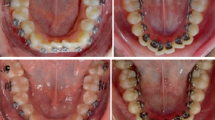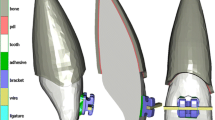Abstract
Purpose
Torque control in lingual orthodontics is key to obtain optimal esthetic results. The aim of this in vitro experimental study was to verify the efficiency of the ligature–archwire–slot system in torque control using a customized lingual appliance.
Methods
An idealized cast with eight extracted human teeth was created and a set of customized lingual brackets was obtained. Tests were performed with the following wires: 0.016″ × 0.022″ nickel-titanium (NiTi), 0.016″ × 0.024″ stainless steel (SS), 0.017″ × 0.025″ βIII titanium (βIIITi), 0.0182″ × 0.0182″ βIIITi, 0.018″ × 0.025″ SS, 0.018″ × 0.025″ NiTi, 0.018″ × 0.025″ βIIITi, and three types of ligatures were tested using a universal testing machine to calculate the efficiency in torque control. A blind statistical analysis was performed.
Results
Based on post hoc multiple comparisons, differences were found for two of the three ligatures when using the 0.016″ × 0.022″ NiTi wires (p < 0.001 for both ligatures). When considering all ligatures, 0.018″ × 0.025″ SS and 0.018″ × 0.025″ βIIITi were significantly different from all other wires (p < 0.001 in all cases). With a moment of 5 Nmm, the 0.016″ × 0.022″ NiTi wire developed median angles of 26.7, 29.8, and 38.7° with the three ligatures, respectively, while the 0.018″ × 0.025″ SS developed median angles of 12.9, 10.7, and 12.7°, respectively.
Conclusions
The ligature type and geometry did not affect the efficiency of torque control, except for the 0.016″ × 0.022″ NiTi wire. The wires generating the greatest moments were the 0.018″ × 0.025″ SS and 0.018″ × 0.025″ βIIITi.
Zusammenfassung
Zweck
Die Torquekontrolle in der lingualen Kieferorthopädie ist ein Schlüsselfaktor, um optimale ästhetische Ergebnisse zu erzielen. Ziel dieser experimentellen In-vitro-Studie war es, die Effizienz des Ligatur-Bogen-Slot Systems bei der Torquekontrolle mit einer individualisierten Lingualapparatur zu überprüfen.
Methoden
Ein idealisiertes Modell mit 8 extrahierten menschlichen Zähnen wurde erstellt und ein Satz individualisierter lingualer Brackets wurde angefertigt. Es wurden Tests mit den folgenden Drähten durchgeführt: 0,016″ × 0,022″ Nickel-Titan (NiTi), 0,016″ × 0,024″ Edelstahl (SS), 0,017″ × 0,025″ βIII-Titan (βIIITi), 0,0182″ × 0,0182″ βIIITi, 0,018″ × 0,025″ SS, 0,018″ × 0,025″ NiTi, 0,018″ × 0,025″ βIIITi. Drei Arten von Ligaturen wurden mit einer Universalprüfmaschine getestet, um das Ausmaß der Torquekontrolle zu berechnen. Eine blinde statistische Analyse wurde durchgeführt.
Ergebnisse
Basierend auf post hoc durchgeführten Mehrfachvergleichen wurden bei der Verwendung der 0,016″ × 0,022″ NiTi-Drähte (p < 0,001 für beide Ligaturen) Unterschiede für 2 der 3 Ligaturen nachgewiesen. Bei Betrachtung aller Ligaturen unterschieden sich 0,018″ × 0,025″ SS und 0,018″ × 0,025″ βIIITi signifikant von allen anderen Drähten (p < 0,001 in allen Fällen). Bei einem Drehmoment von 5 Nmm entwickelte der 0,016″ × 0,022″ NiTi-Draht Medianwinkel von 26,7, 29,8 bzw. 38,7° mit den 3 Ligaturen, der 0,018″ × 0,025″ SS-Draht erzielte dagegen Medianwinkel von 12,9, 10,7 bzw. 12,7°.
Schlussfolgerungen
Ligaturtyp und Geometrie hatten – mit Ausnahme des 0,016″ × 0,022″ NiTi-Drahts – keinen Einfluss auf die Effizienz der Torqueübertragung. Die Drähte, welche die größten Drehmomente erzeugten, waren 0,018″ × 0,025″ SS und 0,018″ × 0,025″ βIIITi.





Similar content being viewed by others
References
Archambault A, Major TW, Carey JP, Heo G, Badawi H, Major PW (2010) A comparison of torque expression between stainless steel, titanium molybdenum alloy, and copper nickel titanium wires in metallic self-ligating brackets. Angle Orthod 80:884–889
Bantleon HP, Droschl H (1988) Front torque using a partial arch technic. J Orofac Orthop 49:203–212
Burstone CJ (1966) The mechanics of the segmented arch techniques. Angle Orthod 36:99–120
Creekmore TDTD (1979) Creekmore on torque. J Clin Orthod 13:305–310
Daratsianos N, Bourauel C, Fimmers R, Jäger A, Schwestka-Polly R (2016) In vitro biomechanical analysis of torque capabilities of various 0.018″ lingual bracket-wire systems: total torque play and slot size. Eur J Orthod 38:459–469
Fulmer DT, Kuftinec MM (1989) Cephalometric appraisal of patients treated with fixed lingual orthodontic appliances: historic review and analysis of cases. Am J Orthod Dentofacial Orthop 95:514–520
Germane N, Bentley BE Jr, Isaacson RJ (1989) Three biologic variables modifying faciolingual tooth angulation by straight-wire appliances. Am J Orthod Dentofacial Orthop 96:312–319
Gmyrek H, Bourauel C, Richter G, Harzer W (2002) Torque capacity of metal and plastic brackets with reference to materials, application, technology and biomechanics. J Orofac Orthop 63:113–128
Harzer W, Bourauel C, Gmyrek H (2004) Torque capacity of metal and polycarbonate brackets with and without a metal slot. Eur J Orthod 26:435–441
Hemingway R, Williams RL, Hunt JA, Rudge SJ (2001) The influence of bracket type on the force delivery of Ni-Ti archwires. Eur J Orthod 23:233–241
Hong RK, Lee JG, Sunwoo J, Lim SM (2000) Lingual orthodontics combined with orthognathic surgery in a skeletal Class III patient. J Clin Orthod 34:403–408
Huang Y, Keilig L, Rahimi A, Reimann S, Eliades T, Jäger A (2009) Numeric modeling of torque capabilities of self-ligating and conventional brackets. Am J Orthod Dentofacial Orthop 136:638–643
Inami T, Nakano Y, Miyazawa K, Tabuchi M, Goto S (2016) Adult skeletal Class II high-angle case treated with a fully customized lingual bracket appliance. Am J Orthod Dentofacial Orthop 150:679–691
Lossdörfer S, Bieber C, Schwestka-Polly R, Wiechmann D (2014) Analysis of the torque capacity of a completely customized lingual appliance of the next generation. Head Face Med 10:4
Major TW, Carey JP, Nobes DS, Heo G, Major PW (2011) Mechanical effects of third-order movement in self-ligated brackets by the measurement of torque expression. Am J Orthod Dentofacial Orthop 139:e31–44
Mathew RN, Katyal A, Shetty A, Nayak KUS (2016) Effect of increasing the vertical intrusive force to obtain torque control in lingual orthodontics: a three-dimensional finite element method study. Indian J Dent Res 27:163–167
Miethke RR, Melsen B (1999) Effect of variation in tooth morphology and bracket position on first and third order correction with preadjusted appliances. Am J Orthod 116:329–335
Morina E, Eliades T, Pandis N, Jäger A, Bourauel C (2008) Torque expression of self-ligating brackets compared with conventional metallic, ceramic, and plastic brackets. Eur J Orthod 30:233–238
Papageorgiou SN, Sifakakis I, Doulis I, Eliades TT, Bourauel C (2016) Torque efficiency of square and rectangular archwires into 0.018 and 0.022 in conventional brackets. Prog Orthod 17:5
Pauls A, Nienkemper M, Schwestka-Polly R, Wiechmann D (2017) Therapeutic accuracy of completely customized lingual appliance WIN: A retrospective cohort study. J Orofac Orthop 78:52–61
R Core Team (2018) A language and environment for statistical computing. R Foundation for Statistical Computing, Vienna (http://www.R-project.org/)
Reitan K (1964) Effects of force magnitude and direction of tooth movement on different alveolar bone types. Angle Orthod 34:244–255
Schudy GF, Schudy FF (1989) Intrabracket space and interbracket distance: critical factors in clinical orthodontics. Am J Orthod Dentofacial Orthop 96:281–294
Sebanc J, Brantley WA, Pincsak JJ, Conover JP (1984) Variability of effective torque as a function of edge bevel on orthodontic arch wires. Am J Orthod 86:43–51
Sifakakis I, Pandis N, Makou M, Eliades T, Katsaros C, Bourauel C (2013) A comparative assessment of torque generated by lingual and conventional brackets. Eur J Orthod 35:375–380
Smith JR, Gorman JC, Kurz C, Dunn RM (1986) Keys to success in lingual therapy. Part 1. J Clin Orthod 20:252–261
Wei L, Qiguo R, Jiuxiang L, Baohua X (2009) Torque control of the maxillary incisors in lingual and labial orthodontics: a 3‑dimensional finite element analysis. Am J Orthod Dentofacial Orthop 135:316–322
Acknowledgements
We would like to thank and remember Professor Marco Capurro: his great contribution as a man, a teacher and a researcher will last in our hearts. We also would like to thank 3M Oral Care for the kind support, assistance and the materials provided for the experiments.
Funding
This research did not receive any specific grant from funding agencies in public, commercial or not-for-profit sectors.
Author information
Authors and Affiliations
Corresponding author
Ethics declarations
Conflict of interest
R. Stradi has a consultancy agreement with 3M Unitek. M. Migliorati, D. Poggio, S. Drago, A. Lagazzo, F. Barberis and A. Silvestrini-Biavati declare that they have no competing interests.
Rights and permissions
About this article
Cite this article
Migliorati, M., Poggio, D., Drago, S. et al. Torque efficiency of a customized lingual appliance. J Orofac Orthop 80, 304–314 (2019). https://doi.org/10.1007/s00056-019-00190-w
Received:
Accepted:
Published:
Issue Date:
DOI: https://doi.org/10.1007/s00056-019-00190-w




